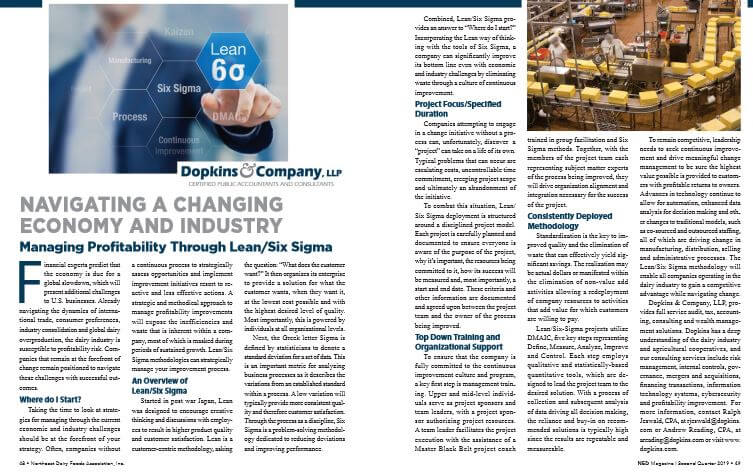Navigating a Changing Economy and Industry: Managing Profitability Through Lean/Six Sigma
September 21, 2020 | Authored by Andrew J. Reading CPA
Originally published September 3, 2019; updated September 21, 2020 –
Financial experts predict that the economy is due for a global slowdown, which will present additional challenges to U.S. businesses. Already navigating the dynamics of international trade, consumer preferences, industry consolidation and global dairy overproduction, the dairy industry is susceptible to profitability risk. Companies that remain at the forefront of change remain positioned to navigate these challenges with successful outcomes”. . . .
…Fast forward to 2020 . . .
Who of us a year ago would have ever predicted how prophetic those words from the introduction of the original publication of our article that follows would become, particularly now living and working during a world-wide pandemic.
From international trade, consumer preference changes, and industry consolidation, the dairy industry is subject to many challenges. In light of the COVID-19 pandemic, we are taking a second look at Dopkins article published in the Northeast Dairy Foods Association, Inc. Magazine. Here we discuss how Lean/Six Sigma can help companies achieve successful outcomes.

Where do I Start?
Taking the time to look at strategies for managing through the current economic and industry challenges should be at the forefront of your strategy. Often, companies without a continuous process to strategically assess opportunities and implement improvement initiatives resort to reactive and less effective actions. A strategic and methodical approach to manage profitability improvements will expose the inefficiencies and waste that is inherent within a company, most of which is masked during periods of sustained growth. Lean/Six Sigma methodologies can strategically manage your improvement process.
An Overview of Lean/Six Sigma
Started in post war Japan, Lean was designed to encourage creative thinking and discussions with employees to result in higher product quality and customer satisfaction. Lean is a customer-centric methodology, asking the question: “What does the customer want?” It then organizes its enterprise to provide a solution for what the customer wants, when they want it, at the lowest cost possible and with the highest desired level of quality. Most importantly, this is powered by individuals at all organizational levels.
Next, the Greek letter Sigma is defined by statisticians to denote a standard deviation for a set of data. This is an important metric for analyzing business processes as it describes the variations from an established standard within a process. A low variation will typically provide more consistent quality and therefore customer satisfaction. Through the process as a discipline, Six Sigma is a problem-solving methodology dedicated to reducing deviations and improving performance.
Combined, Lean/Six Sigma provides an answer to “Where do I start?” Incorporating the Lean way of thinking with the tools of Six Sigma, a company can significantly improve its bottom line even with economic and industry challenges by eliminating waste through a culture of continuous improvement.
Project Focus/Specified Duration
Companies attempting to engage in a change initiative without a process can, unfortunately, discover a “project” can take on a life of its own. Typical problems that can occur are escalating costs, uncontrollable time commitment, creeping project scope and ultimately an abandonment of the initiative.
To combat this situation, Lean/Six Sigma deployment is structured around a disciplined project model. Each project is carefully planned and documented to ensure everyone is aware of the purpose of the project, why it’s important, the resources being committed to it, how its success will be measured and, most importantly, a start and end date. These criteria and other information are documented and agreed upon between the project team and the owner of the process being improved.
Top Down Training and Organizational Support
To ensure that the company is fully committed to the continuous improvement culture and program, a key first step is management training. Upper and mid-level individuals serve as project sponsors and team leaders, with a project sponsor authorizing project resources. A team leader facilitates the project execution with the assistance of a Master Black Belt project coach trained in group facilitation and Six Sigma methods. Together, with the members of the project team each representing subject matter experts of the process being improved, they will drive organization alignment and integration necessary for the success of the project.
Consistently Deployed Methodology
Standardization is the key to improved quality and the elimination of waste that can effectively yield significant savings. The realization may be actual dollars or manifested within the elimination of non-value add activities allowing a redeployment of company resources to activities that add value for which customers are willing to pay.
Lean/Six-Sigma projects utilize DMAIC, five key steps representing Define, Measure, Analyze, Improve and Control. Each step employs qualitative and statistically-based quantitative tools, which are designed to lead the project team to the desired solution. With a process of collection and subsequent analysis of data driving all decision making, the reliance and buy-in on recommended solutions is typically high since the results are repeatable and measureable.
To remain competitive, leadership needs to seek continuous improvement and drive meaningful change management to be sure the highest value possible is provided to customers with profitable returns to owners. Advances in technology continue to allow for automation, enhanced data analysis for decision making and other changes to traditional models, such as co-sourced and outsourced staffing, all of which are driving change in manufacturing, distribution, selling and administrative processes. The Lean/Six Sigma methodology will enable all companies operating in the dairy industry to gain a competitive advantage while navigating change.
Dopkins & Company, LLP, provides full service audit, tax, accounting, consulting and wealth management solutions. Dopkins has a deep understanding of the dairy industry and agricultural cooperatives, and our consulting services include risk management, internal controls, governance, mergers and acquisitions, financing transactions, information technology systems, cybersecurity and profitability improvement.
For a printable copy of the original Northeast Dairy Foods Association Magazine article, please click here.
Read the entire Northeast Dairy Magazine issue.
For more information, contact Andrew Reading, CPA, at areading@dopkins.com.

About the Author
Andrew J. Reading CPA
Andy is a seasoned financial services professional with experience auditing financial systems, programs and processes for clients from a diverse range of industries. He devotes a significant portion of his career to building client relationships that are rooted in an understanding of their operations and goals through all stages of their business life cycle. As a leader of the Firm’s Risk Advisory Services Team, he oversees the design, execution, and implementation of client risk assessment and audit plans.

